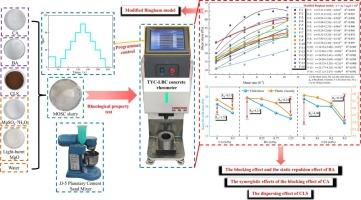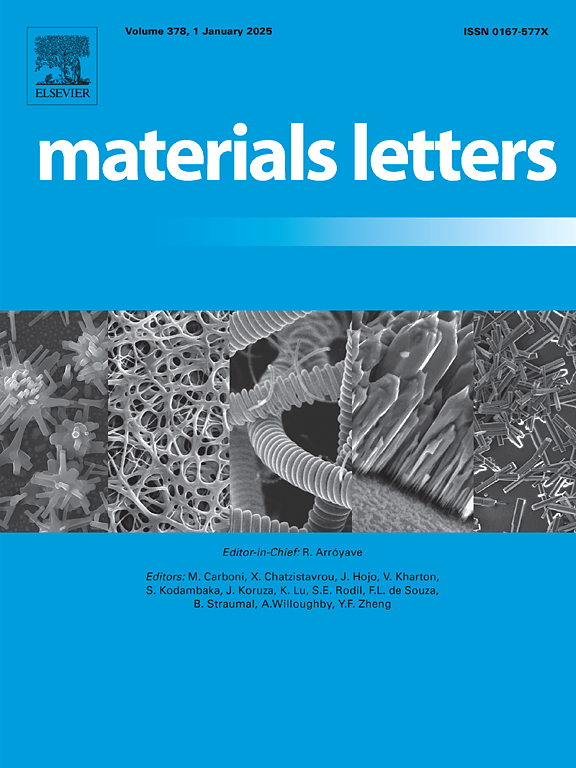添加剂协同改善硫酸氧镁水泥浆流变性能的研究
IF 2.7
4区 材料科学
Q3 MATERIALS SCIENCE, MULTIDISCIPLINARY
引用次数: 0
摘要
硫酸氧镁水泥(MOSC)是一种优良的低碳水泥,但其低流动特性限制了其在隧道裂隙围岩注浆中的应用。因此,在本研究中,通过掺入外加剂来调节MOSC浆体的流变特性。在室内流变试验的基础上,建立了MOSC料浆流变模型,分析了柠檬酸(CA)、硼酸(BA)和木质素磺酸钙(CLS)对MOSC料浆流变性能的协同改性机理。结果表明:改性moc浆体流变演化符合修正Bingham模型;CA、BA和CLS的含量与料浆的流动性能呈正相关,其中CLS对料浆流变性能的改善能力更强。CA的阻断效应、BA的阻断效应和静电斥力效应以及CLS的分散效应是MOSC流变性能增强的主要原因。本文章由计算机程序翻译,如有差异,请以英文原文为准。

Study on synergistic improvement of rheological properties of magnesium oxysulfate cement slurry by additives
Magnesium oxysulfate cement (MOSC) is an excellent low-carbon cement, but its low flow properties limit its application in the grouting of fractured surrounding rocks in tunnels. Therefore, in this study, the rheological properties of MOSC slurry were adjusted by incorporating admixtures. Based on the indoor rheological tests, the rheological model of MOSC slurry was established, and the synergistic modification mechanism of citric acid (CA), boric acid (BA) and calcium lignosulfonate (CLS) on the rheological properties of MOSC slurry was analysed. The results showed that the rheological evolution of the modified MOSC slurry was in accordance with the Modified Bingham model. The contents of CA, BA and CLS were positively correlated with the flow properties of the slurry, with CLS having a stronger ability to improve the rheological properties of the slurry. The blocking effect of CA, the blocking effect and electrostatic repulsion effect of BA, and the dispersing effect of CLS were the main reasons for the enhancement of the rheological properties of MOSC.
求助全文
通过发布文献求助,成功后即可免费获取论文全文。
去求助
来源期刊

Materials Letters
工程技术-材料科学:综合
CiteScore
5.60
自引率
3.30%
发文量
1948
审稿时长
50 days
期刊介绍:
Materials Letters has an open access mirror journal Materials Letters: X, sharing the same aims and scope, editorial team, submission system and rigorous peer review.
Materials Letters is dedicated to publishing novel, cutting edge reports of broad interest to the materials community. The journal provides a forum for materials scientists and engineers, physicists, and chemists to rapidly communicate on the most important topics in the field of materials.
Contributions include, but are not limited to, a variety of topics such as:
• Materials - Metals and alloys, amorphous solids, ceramics, composites, polymers, semiconductors
• Applications - Structural, opto-electronic, magnetic, medical, MEMS, sensors, smart
• Characterization - Analytical, microscopy, scanning probes, nanoscopic, optical, electrical, magnetic, acoustic, spectroscopic, diffraction
• Novel Materials - Micro and nanostructures (nanowires, nanotubes, nanoparticles), nanocomposites, thin films, superlattices, quantum dots.
• Processing - Crystal growth, thin film processing, sol-gel processing, mechanical processing, assembly, nanocrystalline processing.
• Properties - Mechanical, magnetic, optical, electrical, ferroelectric, thermal, interfacial, transport, thermodynamic
• Synthesis - Quenching, solid state, solidification, solution synthesis, vapor deposition, high pressure, explosive
 求助内容:
求助内容: 应助结果提醒方式:
应助结果提醒方式:


